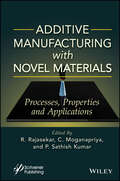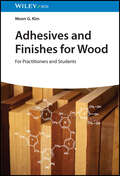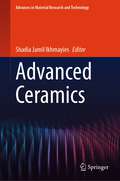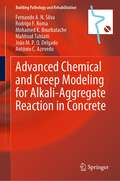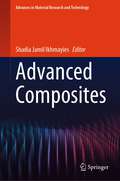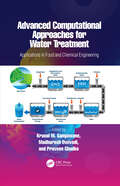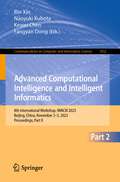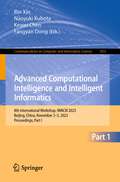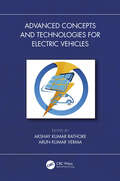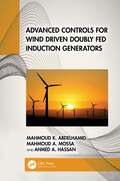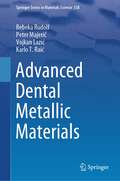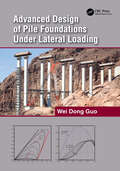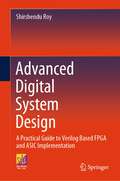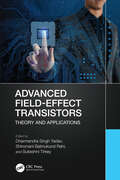- Table View
- List View
Additive Manufacturing with Novel Materials: Process, Properties and Applications
by R. Rajasekar C. Moganapriya P. Sathish KumarADDITIVE MANUFACTURING With NOVEL MATERIALS The book explores practically the latest advancements and techniques in 3D and 4D printing using innovative and unconventional materials. This book comprehensively provides insights into various additive manufacturing processes, novel materials, and their properties, as well as the basic knowledge of AM process parameters, post-processing techniques, and their applications. It also explores the fundamental concepts and recent advancements in the development of novel materials for several applications, with special emphasis on platforms like AM techniques for polymers, ceramics, metallic materials, composites, nanomaterials, hydrogels, etc. Specific topics like environmental aspects of 3D printing and advanced 4D printing are also introduced. The technological aspects of AM are discussed in a concise and understandable way, with extensive illustrations. Also covered are the challenges and opportunities that arise from 3D printing with these materials. Audience The book will benefit researchers and industry engineers who work in additive manufacturing, mechanical engineering, 3D/4D printing, and materials science.
Addressing the Climate Crisis in the Indian Himalayas: Can Traditional Ecological Knowledge Help?
by Anwesha Borthakur Pardeep SinghThis book focuses on the traditional ecological knowledge in addressing the current climate crisis in the Indian Himalayas. Local or indigenous people in the Himalayas, through their low-carbon producing lifestyles, contribute very little to the climate crisis. However, at the same time, they bear the brunt of this crisis way more than many others. It is important to learn about their traditional ways of life and the knowledge that they hold regarding ecology and environment. Traditional ecological knowledge and associated belief systems are given increasing attention across the globe in recent times toward addressing some of the grave environmental concerns. Climate change is one such concern. The rising consideration of concepts such as ethnoecology and ethnobotany signifies the scientific, socio-cultural and economic potential of the traditional ecological knowledge systems. It is indisputable that these knowledge systems have the ability to provide important insights towards tackling many present-day environmental distresses including several climate change challenges. In this book, the authors concentrate on such traditional ecological knowledge systems in the Indian Himalayan region and try to figure out their significance in relation to the modern science. Overall, the authors attempt to write a book where the relevance of traditional ecological knowledge systems could be addressed and communicated to a larger audience—both academic scientific and non-academic.
Adhesives and Finishes for Wood: For Practitioners and Students
by Moon G. KimAdhesives and Finishes for Wood Understand the science of joining wood with this comprehensive guide Long seen as an old-fashioned material with narrowing modern applications, wood has seen increased popularity as a material in building and manufacturing in recent years. This has been driven by the need for sustainable resources and environmentally friendly materials. As a result of increased emphasis on wood, however, there is a corresponding need to understand the wood adhesives, the crucial materials in wood-based manufacture and craftsmanship. Adhesives and Finishes for Wood meets this need with a comprehensive but accessible introduction to the chemistry and applications of wood adhesives. Its easy-to-follow presentation nonetheless presents wood adhesives and finishes in significant detail. Ideal for readers without considerable preexisting knowledge in chemistry, this book includes everything the reader needs to understand and apply wood adhesives in their work or industry. Adhesives and Finishes for Wood readers will also find: Coverage ranging from the fundamentals of wood adhesive polymer chemistry to the properties of specific wood structures and resins A presentation suitable for both academic students and wood manufacture professionals An author with decades of experience in both academia and industry Adhesives and Finishes for Wood is a useful reference for advanced students and professionals in industries or manufacturing disciplines that incorporate wood, as well as for chemists, materials scientists, vocational school instructors, and more.
Adhesives and Finishes for Wood: For Practitioners and Students
by Moon G. KimAdhesives and Finishes for Wood Understand the science of joining wood with this comprehensive guide Long seen as an old-fashioned material with narrowing modern applications, wood has seen increased popularity as a material in building and manufacturing in recent years. This has been driven by the need for sustainable resources and environmentally friendly materials. As a result of increased emphasis on wood, however, there is a corresponding need to understand the wood adhesives, the crucial materials in wood-based manufacture and craftsmanship. Adhesives and Finishes for Wood meets this need with a comprehensive but accessible introduction to the chemistry and applications of wood adhesives. Its easy-to-follow presentation nonetheless presents wood adhesives and finishes in significant detail. Ideal for readers without considerable preexisting knowledge in chemistry, this book includes everything the reader needs to understand and apply wood adhesives in their work or industry. Adhesives and Finishes for Wood readers will also find: Coverage ranging from the fundamentals of wood adhesive polymer chemistry to the properties of specific wood structures and resins A presentation suitable for both academic students and wood manufacture professionals An author with decades of experience in both academia and industry Adhesives and Finishes for Wood is a useful reference for advanced students and professionals in industries or manufacturing disciplines that incorporate wood, as well as for chemists, materials scientists, vocational school instructors, and more.
Advanced Ceramics (Advances in Material Research and Technology)
by Shadia Jamil IkhmayiesThis book presents the fundamentals of advanced ceramics, their stages of development, types and classifications, advanced processing techniques, properties, sintering, and new forms of applications. It highlights specific examples such as alumina, zirconia, Mg-Al-spinels, silicon carbide, silicon nitride, ceramic composites, and thin films with their specific applications. The book reviews progress in perovskite ceramics, in which the synthesis, processing, characterization, and advanced applications of perovskite ceramics are all thoroughly discussed. In addition, developments of perovskite solar cells, the main factors affecting their stability, current problems, development prospects in the research, and application of perovskite solar cells are all highlighted. This book also includes a review of a particular class of rare-earth-based mixed-metal oxides, namely Ln2B2O7 nanostructures (B = Zr, Sn, and Ce), where advantages and disadvantages of each production technique are addressed along with the properties of as-produced nanostructures. The solar photocatalytic uses of Ln2B2O7 nanostructures such as photodegradation of contaminants are also discussed. Yttria-based transparent ceramics for photonic applications are reviewed, along with a discussion of powder synthesis, green body preparation, sintering, and optical properties. In addition, the fundamentals of electrophoretic deposition of hydroxyapatite incorporated composite coatings on metallic substrates are presented and discussed. The different types of ceramics-based self-healing coatings and their fabrication processes have also been reported and discussed in this book. These include titania, zirconia, titanium-alumina, and zirconia-alumina incorporated with Benzotriazole (BTA) as an inhibitor. Advanced ceramic materials that have been used for the purpose of wastewater treatment including ceramic sorbents, resins, aerosols, and ceramic membranes that have been widely used for wastewater treatment purposes are also discussed in depth.Moreover, the book presents the preparation of geopolymers by microwave treatments and explains how their properties can be tuned using microwaves. Furthermore, the future and perspective of these advanced ceramic materials and their modifications to ensure better efficacy toward environmental remediation purposes are highlighted in this book.
Advanced Chassis Control Technology for Steer-by-Wire Vehicles
by Xiaodong WuAdvanced Chassis Control Technology for Steer-by-Wire Vehicles details state-of-the-art drive-by-wire technology, enabling engineers to create safer and smarter steering technology. With applications in Formula 1 driving, this book is an accessible yet ambitious introduction to the technology that is fast becoming the future of road vehicles.Steer-by-wire systems replace conventional mechanical technology with electronic sensors, controllers, and actuators, enhancing functionality when steering. Features such as variable steer ratio, customized road feel, and advanced vehicle dynamics control all ensure that this maximizes safety when driving. The book looks first at the theory behind this technology and compares it to conventional mechanical steering. It discusses control through forward and backward dynamics and a shared steering control concept to improve vehicle handling and performance, relevant to intelligent vehicles. It also explains how to create chassis domain fusion control, four independent wheels steering system and teleoperated control. Using case studies and ISOs, the book is a practical guide to safely designing steer-by-wire systems.The book is an essential guide to all engineers working in the modern automotive industry.
Advanced Chassis Control Technology for Steer-by-Wire Vehicles
by Xiaodong WuAdvanced Chassis Control Technology for Steer-by-Wire Vehicles details state-of-the-art drive-by-wire technology, enabling engineers to create safer and smarter steering technology. With applications in Formula 1 driving, this book is an accessible yet ambitious introduction to the technology that is fast becoming the future of road vehicles.Steer-by-wire systems replace conventional mechanical technology with electronic sensors, controllers, and actuators, enhancing functionality when steering. Features such as variable steer ratio, customized road feel, and advanced vehicle dynamics control all ensure that this maximizes safety when driving. The book looks first at the theory behind this technology and compares it to conventional mechanical steering. It discusses control through forward and backward dynamics and a shared steering control concept to improve vehicle handling and performance, relevant to intelligent vehicles. It also explains how to create chassis domain fusion control, four independent wheels steering system and teleoperated control. Using case studies and ISOs, the book is a practical guide to safely designing steer-by-wire systems.The book is an essential guide to all engineers working in the modern automotive industry.
Advanced Chemical and Creep Modeling for Alkali-Aggregate Reaction in Concrete (Building Pathology and Rehabilitation #28)
by Fernando A. Silva Rodrigo F. Roma Mohamed K. Bourbatache Mahfoud Tahlaiti João M. Delgado António C. AzevedoThis book presents the numerical results of the use of the chemical model to analyse the advancement of the reaction and the mechanical model to simulate creep and shrinkage phenomena in COMSOL Multiphysics®, as a way to reassess concrete structures suffering from those mechanisms. Both models were implemented separately to evaluate their responses and compare them with the theoretical results and experimental benchmarks presented in the literature. The numerical simulation results showed excellent agreement with the experimental results data, with maximum disagreement not exceeding 10%, indicating that the implementation of the developed numerical models behaved very efficiently.
Advanced Composites (Advances in Material Research and Technology)
by Shadia Jamil IkhmayiesThis book presents a comprehensive collection of reviews and experimental research findings in the realm of composite materials. It explores manufacturing technologies and applications, as well as recent breakthroughs in nanomaterial-based composites, polymer-based composites, titanium matrix composites (TMCs), conducting polymers, natural polymers, graphene polymers, graphene composites, and organosulfur polymeric composites, alongside reinforced aluminum matrix composites. The mechanical and tribological aspects take center stage, with a focus on aluminum alloy composites as a superior alternative to traditional gear materials. The book also addresses cutting-edge composite materials developed for drug removal via adsorption techniques, radiation shielding, and their use as shielding absorbers for ionizing radiation. Furthermore, the significance of electrical contact materials and their performance is explored. The book unveils fabrication methods, sample preparation techniques, properties, and various applications of these remarkable composites. Topics range from additive manufacturing to solid-phase extraction and solid-phase microextraction utilizing diverse composites as adsorbents. Additionally, the inverse vulcanization process, a novel technique involving the copolymerization of elemental sulfur with different monomers based on their resource origins, is discussed. Technologies such as powder metallurgy (PM), mechanical alloying (MA), self-propagating high-temperature synthesis (SHS), and rapid solidification processing (RSP) are described. The book further delves into the preparation techniques of zeolite using both conventional and advanced methods, along with the synthesis of various zeolite-based composites, particularly their application in environmental remediation. The book culminates with a summary of analysis and modeling techniques used in composite materials, including those employed in ballistic applications.
Advanced Computational Approaches for Water Treatment: Applications in Food and Chemical Engineering
by Krunal M Gangawane Madhuresh Dwivedi Praveen GhodkeA rapid growth in global industrialization and population has triggered intense environmental pollution that has led to a water crisis, resulting in the decay in the quality of human life and economic losses. Novel water purification techniques are expected to alleviate this challenge. Recently, various water purification techniques, along with different computational techniques, have been developed. For instance, water purification techniques, such as electromagnetic water purification, solute-surface interactions in water, use of micro-magnetofluidic devices, UV-led water purification, and use of membranes can be thoroughly investigated by using a range of computation techniques, such as molecular dynamics, the lattice Boltzmann method, and the Navier-Stokes method-based solver. Advanced Computational Approaches for Water Treatment: Applications in Food and Chemical Engineering, presents these different numerical techniques and traditional modeling and simulation approaches to elaborate on and explain the various water purification techniques. Features: Serves as a dedicated reference for this emerging topic Discusses state of the art developments in advanced computational techniques for water purification Brings together diverse experience in this field in one reference text Provides a roadmap for future developments in the area This book is primarily intended for chemical engineers, hydrologists, water resource managers, civil engineers, environmental engineers, food scientists and food engineers interested in understanding the numerical approaches for different water purification techniques, such as membrane, sedimentation, filtration, micromagnetofluidic device, and ozone/UV, among others.
Advanced Computational Approaches for Water Treatment: Applications in Food and Chemical Engineering
by Krunal M. Gangawane Madhuresh Dwivedi Praveen GhodkeA rapid growth in global industrialization and population has triggered intense environmental pollution that has led to a water crisis, resulting in the decay in the quality of human life and economic losses. Novel water purification techniques are expected to alleviate this challenge. Recently, various water purification techniques, along with different computational techniques, have been developed. For instance, water purification techniques, such as electromagnetic water purification, solute-surface interactions in water, use of micro-magnetofluidic devices, UV-led water purification, and use of membranes can be thoroughly investigated by using a range of computation techniques, such as molecular dynamics, the lattice Boltzmann method, and the Navier-Stokes method-based solver. Advanced Computational Approaches for Water Treatment: Applications in Food and Chemical Engineering, presents these different numerical techniques and traditional modeling and simulation approaches to elaborate on and explain the various water purification techniques. Features: Serves as a dedicated reference for this emerging topic Discusses state of the art developments in advanced computational techniques for water purification Brings together diverse experience in this field in one reference text Provides a roadmap for future developments in the area This book is primarily intended for chemical engineers, hydrologists, water resource managers, civil engineers, environmental engineers, food scientists and food engineers interested in understanding the numerical approaches for different water purification techniques, such as membrane, sedimentation, filtration, micromagnetofluidic device, and ozone/UV, among others.
Advanced Computational Intelligence and Intelligent Informatics: 8th International Workshop, IWACIII 2023, Beijing, China, November 3–5, 2023, Proceedings, Part II (Communications in Computer and Information Science #1932)
by Bin Xin Naoyuki Kubota Kewei Chen Fangyan DongThis two-volume set constitutes the refereed proceedings of the 8th International Workshop on Advanced Computational Intelligence and Intelligent Informatics, IWACIII 2023, held in Beijing, China, in November 2023.The 56 papers presented were thoroughly reviewed and selected from the 118 qualifies submissions. They are organized in the topical sections on intelligent information processing; intelligent optimization and decision-making; pattern recognition and computer vision; advanced control; multi-agent systems; robotics.
Advanced Computational Intelligence and Intelligent Informatics: 8th International Workshop, IWACIII 2023, Beijing, China, November 3–5, 2023, Proceedings, Part I (Communications in Computer and Information Science #1931)
by Bin Xin Naoyuki Kubota Kewei Chen Fangyan DongThis two-volume set constitutes the refereed proceedings of the 8th International Workshop on Advanced Computational Intelligence and Intelligent Informatics, IWACIII 2023, held in Beijing, China, in November 2023.The 56 papers presented were thoroughly reviewed and selected from the 118 qualifies submissions. They are organized in the topical sections on intelligent information processing; intelligent optimization and decision-making; pattern recognition and computer vision; advanced control; multi-agent systems; robotics.
Advanced Concepts and Technologies for Electric Vehicles
This book explains the basic and advanced technology behind the Power Electronics Converters for EV charging, and their significant developments, and introduces the Grid Impact issues that underpin the grid integration of electric vehicles. Advanced Concepts and Technologies for Electric Vehicles reviews state-of-the-art and new configurations and concepts of more electric vehicles and EV charging, mitigating the impact of EV charging on the power grid, and technical considerations of EV charging infrastructures. The book considers the environmental benefits and advantages of electric vehicles and their component devices. It includes case studies of different power electronic converters used for charging EVs. It offers a review of PFC-based AC chargers, WBG-based chargers, and Wireless chargers. The authors also explore multistage charging systems and their possible implementations. The book also examines the challenges and opportunities posed by the progressive integration of electric drive vehicles on the power grid and reported solutions for their mitigation. The book is intended for professionals, researchers, and engineers in the electric vehicle industry as well as advanced students in electrical engineering who benefit from this comprehensive coverage of electric vehicle technology. Readers can get an in-depth insight into the technology deployment in EV transportation and utilize that knowledge to develop novel ideas in the EV area.
Advanced Concepts and Technologies for Electric Vehicles
by Akshay Kumar Rathore Arun Kumar VermaThis book explains the basic and advanced technology behind the Power Electronics Converters for EV charging, and their significant developments, and introduces the Grid Impact issues that underpin the grid integration of electric vehicles. Advanced Concepts and Technologies for Electric Vehicles reviews state-of-the-art and new configurations and concepts of more electric vehicles and EV charging, mitigating the impact of EV charging on the power grid, and technical considerations of EV charging infrastructures. The book considers the environmental benefits and advantages of electric vehicles and their component devices. It includes case studies of different power electronic converters used for charging EVs. It offers a review of PFC-based AC chargers, WBG-based chargers, and Wireless chargers. The authors also explore multistage charging systems and their possible implementations. The book also examines the challenges and opportunities posed by the progressive integration of electric drive vehicles on the power grid and reported solutions for their mitigation. The book is intended for professionals, researchers, and engineers in the electric vehicle industry as well as advanced students in electrical engineering who benefit from this comprehensive coverage of electric vehicle technology. Readers can get an in-depth insight into the technology deployment in EV transportation and utilize that knowledge to develop novel ideas in the EV area.
Advanced Control of Grid-Integrated Renewable Energy Power Plants: LMI-based Design in the Takagi-Sugeno Framework (IEEE Press)
by Horst SchultePresents the principles, derivations, and equations of renewable energy power plants, including MATLAB code Advanced Control of Grid-Integrated Renewable Energy Power Plants presents a comprehensive introduction to the power system dynamics and stability of renewable energy power plants (RPPs), such as wind turbines, wind power plants, and photovoltaic systems. The author—a noted expert on the topic—takes a rigorous approach to the analysis and modelling of RPPs, such as turbine rotors, PV cells, electronic converters, transformers, and aggregated grid models. This approach allows for the validation of requirements for sustainable power systems based on formal methods. The text deals with nonlinear model-based observer and control design techniques in the Takagi-Sugeno (TS) framework. It explores the Takagi-Sugeno fuzzy (TSF) models which are nonlinear systems, in which the consequent part of a fuzzy rule is a mathematical formula, representing local dynamics or limited nonlinearities by sector functions. The strong property of the TSF finds several applications modelling dynamical systems that can be described by differential equations. The book’s practical exercises use MATLAB code to help model simulation models of single large-scale wind turbines, wind farms, and photovoltaic plants. This important book: Provides a complete introduction to the power system dynamics and stability of renewable energy power plants Includes a detailed discussion of how to design model model-based controllers for RPPs Takes a rigorous approach to the analysis and modelling of RPPs, including turbine rotors, PV cells, electronic converters, transformers, aggregated grid models, and more Includes MATLAB code to model simulation models of single large-scale wind turbines, wind farms, and photovoltaic plants Written for students and researchers of renewable energy, Advanced Control of Grid-Integrated Renewable Energy Power Plants offers an authoritative text to the topic.
Advanced Control of Grid-Integrated Renewable Energy Power Plants: LMI-based Design in the Takagi-Sugeno Framework (IEEE Press)
by Horst SchultePresents the principles, derivations, and equations of renewable energy power plants, including MATLAB code Advanced Control of Grid-Integrated Renewable Energy Power Plants presents a comprehensive introduction to the power system dynamics and stability of renewable energy power plants (RPPs), such as wind turbines, wind power plants, and photovoltaic systems. The author—a noted expert on the topic—takes a rigorous approach to the analysis and modelling of RPPs, such as turbine rotors, PV cells, electronic converters, transformers, and aggregated grid models. This approach allows for the validation of requirements for sustainable power systems based on formal methods. The text deals with nonlinear model-based observer and control design techniques in the Takagi-Sugeno (TS) framework. It explores the Takagi-Sugeno fuzzy (TSF) models which are nonlinear systems, in which the consequent part of a fuzzy rule is a mathematical formula, representing local dynamics or limited nonlinearities by sector functions. The strong property of the TSF finds several applications modelling dynamical systems that can be described by differential equations. The book’s practical exercises use MATLAB code to help model simulation models of single large-scale wind turbines, wind farms, and photovoltaic plants. This important book: Provides a complete introduction to the power system dynamics and stability of renewable energy power plants Includes a detailed discussion of how to design model model-based controllers for RPPs Takes a rigorous approach to the analysis and modelling of RPPs, including turbine rotors, PV cells, electronic converters, transformers, aggregated grid models, and more Includes MATLAB code to model simulation models of single large-scale wind turbines, wind farms, and photovoltaic plants Written for students and researchers of renewable energy, Advanced Control of Grid-Integrated Renewable Energy Power Plants offers an authoritative text to the topic.
Advanced Controls for Wind Driven Doubly Fed Induction Generators
by Mahmoud K. Abdelhamid Mahmoud A. Mossa Ahmed A. HassanAdvanced Controls for Wind Driven Doubly Fed Induction Generators discusses the most advanced control algorithms used for enhancing the dynamics of a doubly fed induction generator (DFIG) operating at fixed and variable speeds, and which are used for different utilization purposes (standalone and grid connection). Extensive generator performance analysis has been introduced using various control topologies. Features: Presents modeling of wind energy conversion systems (WECS), including a wind turbine as a prime mover, a DFIG as a generation unit for electrical energy, and a three-phase induction motor as an isolated load Explores a detailed description for the presented control algorithms in order to visualize the base principle of each method Introduces a comprehensive performance analysis for the DFIG using the formulated predictive voltage control scheme and other control techniques under different operating conditions Examines the formulation of new control approaches which overcome the shortages present in previous DFIG control schemes Presents a detailed comparison between different control topologies for the DFIG to outline the most effective procedure in terms of dynamic response, structure simplicity, ripples, total harmonic distortion, and computational burdens The book is written for researchers and academics working on advanced control systems and those interested in areas such as machine drives, renewable energy systems, 'adaptive control', modeling of WECS, and optimization theory.
Advanced Controls for Wind Driven Doubly Fed Induction Generators
by Mahmoud K. Abdelhamid Mahmoud A. Mossa Ahmed A. HassanAdvanced Controls for Wind Driven Doubly Fed Induction Generators discusses the most advanced control algorithms used for enhancing the dynamics of a doubly fed induction generator (DFIG) operating at fixed and variable speeds, and which are used for different utilization purposes (standalone and grid connection). Extensive generator performance analysis has been introduced using various control topologies. Features: Presents modeling of wind energy conversion systems (WECS), including a wind turbine as a prime mover, a DFIG as a generation unit for electrical energy, and a three-phase induction motor as an isolated load Explores a detailed description for the presented control algorithms in order to visualize the base principle of each method Introduces a comprehensive performance analysis for the DFIG using the formulated predictive voltage control scheme and other control techniques under different operating conditions Examines the formulation of new control approaches which overcome the shortages present in previous DFIG control schemes Presents a detailed comparison between different control topologies for the DFIG to outline the most effective procedure in terms of dynamic response, structure simplicity, ripples, total harmonic distortion, and computational burdens The book is written for researchers and academics working on advanced control systems and those interested in areas such as machine drives, renewable energy systems, 'adaptive control', modeling of WECS, and optimization theory.
Advanced Dental Metallic Materials (Springer Series in Materials Science #338)
by Rebeka Rudolf Peter Majerič Vojkan Lazić Karlo T. RaićThis book delivers a broad and concise look at advanced metallic materials used for dental applications. Due to their excellent mechanical and biological properties, the use of metallic materials in dentistry has continued since time immemorial. In that sense, this book aims to bring the readers closer to the specific purpose of dental metallic materials meeting specific criteria and materials properties such as biocompatibility, non-toxicity, resistance to corrosion, long-term durability, appropriate strength and toughness, as well as corresponding values of modulus of elasticity. Following a comprehensive introduction to the field, the book discusses topical issues such as the long-term stability of dental titanium implants, processing of cobalt-chrome dental alloys, emerging gold dental alloys, and novel nanofoils used for dental joining. Featuring numerous illustrative examples of experimental outcomes, this book is an ideal resource for materials scientists and metallurgists working on advanced alloys for dental applications.
Advanced Design of Pile Foundations Under Lateral Loading
by Wei Dong GuoThis book presents models that capture the nonlinear response of piles subjected to lateral forces. Utilising a consistent approach encompassing new mathematical models, it offers solutions presented as closed-form expressions and underpinned by the same set of 3-5 measurable soil-input parameters. These focus on nonlinear response of mono piles, anchored piles, pile groups, and torsional piles, as well as passive piles subjected to soil movement induced in shearing, sliding slopes or excavation, and earthquake shaking. The models can also be used for pipelines and similar beam structures. Solutions are provided in the form of design charts, with each parameter obtained using available test data and illustrated with real-world cases. The models reveal, for the first time, the mysterious mechanisms of amplification resulting from back-rotation, which have incurred the collapse of structures such as the Showa Bridge and Nicoll Highway, as well as the distortion of piles during earthquakes. Advanced Design of Pile Foundations Under Lateral Loading is ideal for practicing foundation engineers and students at graduate level. Wei Dong Guo is co-founder of Hans Innovation Group and former Associate Professor at the University of Wollongong, Australia. He is a Chartered Professional Engineer and is a Fellow of Engineers Australia by whom he was awarded the 2012 Warren Medal.
Advanced Design of Pile Foundations Under Lateral Loading
by Wei Dong GuoThis book presents models that capture the nonlinear response of piles subjected to lateral forces. Utilising a consistent approach encompassing new mathematical models, it offers solutions presented as closed-form expressions and underpinned by the same set of 3-5 measurable soil-input parameters. These focus on nonlinear response of mono piles, anchored piles, pile groups, and torsional piles, as well as passive piles subjected to soil movement induced in shearing, sliding slopes or excavation, and earthquake shaking. The models can also be used for pipelines and similar beam structures. Solutions are provided in the form of design charts, with each parameter obtained using available test data and illustrated with real-world cases. The models reveal, for the first time, the mysterious mechanisms of amplification resulting from back-rotation, which have incurred the collapse of structures such as the Showa Bridge and Nicoll Highway, as well as the distortion of piles during earthquakes. Advanced Design of Pile Foundations Under Lateral Loading is ideal for practicing foundation engineers and students at graduate level. Wei Dong Guo is co-founder of Hans Innovation Group and former Associate Professor at the University of Wollongong, Australia. He is a Chartered Professional Engineer and is a Fellow of Engineers Australia by whom he was awarded the 2012 Warren Medal.
Advanced Digital System Design: A Practical Guide to Verilog Based FPGA and ASIC Implementation
by Shirshendu RoyThe book is designed to serve as a textbook for courses offered to undergraduate and graduate students enrolled in electrical, electronics, and communication engineering. The objective of this book is to help the readers to understand the concepts of digital system design as well as to motivate the students to pursue research in this field. Verilog Hardware Description Language (HDL) is preferred in this book to realize digital architectures. Concepts of Verilog HDL are discussed in a separate chapter and many Verilog codes are given in this book for better understanding. Concepts of system Verilog to realize digital hardware are also discussed in a separate chapter. The book covers basic topics of digital logic design like binary number systems, combinational circuit design, sequential circuit design, and finite state machine (FSM) design. The book also covers some advanced topics on digital arithmetic like design of high-speed adders, multipliers, dividers, square root circuits, and CORDIC block. The readers can learn about FPGA and ASIC implementation steps and issues that arise at the time of implementation. One chapter of the book is dedicated to study the low-power design techniques and another to discuss the concepts of static time analysis (STA) of a digital system. Design and implementation of many digital systems are discussed in detail in a separate chapter. In the last chapter, basics of some advanced FPGA design techniques like partial re-configuration and system on chip (SoC) implementation are discussed. These designs can help the readers to design their architecture. This book can be very helpful to both undergraduate and postgraduate students and researchers.
Advanced Field-Effect Transistors: Theory and Applications
Advanced Field-Effect Transistors: Theory and Applications offers a fresh perspective on the design and analysis of advanced field-effect transistor (FET) devices and their applications. The text emphasizes both fundamental and new paradigms that are essential for upcoming advancement in the field of transistors beyond complementary metal–oxide–semiconductors (CMOS). This book uses lucid, intuitive language to gradually increase the comprehension of readers about the key concepts of FETs, including their theory and applications. In order to improve readers’ learning opportunities, Advanced Field-Effect Transistors: Theory and Applications presents a wide range of crucial topics: • Design and challenges in tunneling FETs • Various modeling approaches for FETs • Study of organic thin-film transistors • Biosensing applications of FETs • Implementation of memory and logic gates with FETs The advent of low-power semiconductor devices and related implications for upcoming technology nodes provide valuable insight into low-power devices and their applicability in wireless, biosensing, and circuit aspects. As a result, researchers are constantly looking for new semiconductor devices to meet consumer demand. This book gives more details about all aspects of the low-power technology, including ongoing and prospective circumstances with fundamentals of FET devices as well as sophisticated low-power applications.
Advanced Field-Effect Transistors: Theory and Applications
by Dharmendra Singh Yadav Shiromani Balmukund Rahi Sukeshni TirkeyAdvanced Field-Effect Transistors: Theory and Applications offers a fresh perspective on the design and analysis of advanced field-effect transistor (FET) devices and their applications. The text emphasizes both fundamental and new paradigms that are essential for upcoming advancement in the field of transistors beyond complementary metal–oxide–semiconductors (CMOS). This book uses lucid, intuitive language to gradually increase the comprehension of readers about the key concepts of FETs, including their theory and applications. In order to improve readers’ learning opportunities, Advanced Field-Effect Transistors: Theory and Applications presents a wide range of crucial topics: • Design and challenges in tunneling FETs • Various modeling approaches for FETs • Study of organic thin-film transistors • Biosensing applications of FETs • Implementation of memory and logic gates with FETs The advent of low-power semiconductor devices and related implications for upcoming technology nodes provide valuable insight into low-power devices and their applicability in wireless, biosensing, and circuit aspects. As a result, researchers are constantly looking for new semiconductor devices to meet consumer demand. This book gives more details about all aspects of the low-power technology, including ongoing and prospective circumstances with fundamentals of FET devices as well as sophisticated low-power applications.
